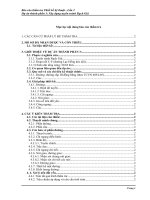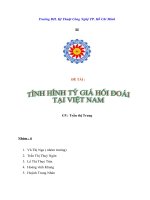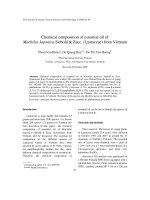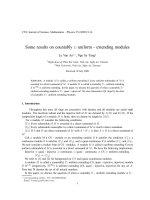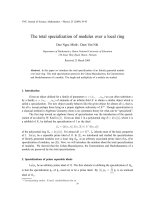Tài liệu Báo cáo " The establishment of the Vietnam atomic time scale " docx
Bạn đang xem bản rút gọn của tài liệu. Xem và tải ngay bản đầy đủ của tài liệu tại đây (119.55 KB, 10 trang )
VNU Journal of Science, Mathematics - Physics 25 (2009) 107-116
107
The establishment of the Vietnam atomic time scale
Le Van Ninh
*
, Nguyen Bang, Nguyen Thi Hang
Trieu Viet Phuong, Nguyen Duc Trung
Vietnam Metrology Institute (VMI), 8 Hoang Quoc Viet, Cau Giay, Hanoi, Vietnam
Received 27 May 2009; received in revised form 9 July 2009
Abstract. The national metrology institutes always establish their time scale UTC(k) (UTC of k
laboratory) based on the atomic clocks. Atomic clocks and a time scale algorithm provides an
ensemble time which is better than any component clock in the system. This paper introduces
establishing of Vietnam time scale UTC(VMI) (UTC of Vietnam Metrology Institute) using the
comparison data of commercial ceasium atomic clocks. We applied the time scale algorithm
named AT1 and an own our method and present instrument at the time and frequency laboratory –
VMI. UTC(VMI) data has appeared on the BIPM website since 2008.
1. Introduction
Time is one of seven of basic quantities so creating and maintaining the national time scale is one
of the task which are belong to the national metrology institutes. In order to creating and maintaining a
national time scale the time and frequency laboratory in a national metrology institute always operates
a time system which includes many atomic clocks (which are commercial or created by themselves)
and a lot of measurement, comparison instruments. Furthermore a time scale algorithm must be
studied based on the data which are from the comparison of separated atomic clocks. The time scale
algorithm processes clock comparison data resulting in a ensemble time which is more stable than any
component atomic clock. At present time community in the world has been using algorithm named
ALGOS and AT1 [2]. ALGOS has been using by Bureau International des Poids et Mesures (BIPM)
for establishing International Atomic Time (TAI) which has good long stability. AT1 has been using
by National Institute of Standards and Technology (NIST) for creating AT1 which is a real time scale.
As recommended by BIPM the national metrology institutes should keep the time difference between
their own the time scale UTC(k) and Coordinated Universal Time (UTC) to be smaller than 100 ns,
the national metrology institutes always apply AT1 algorithm for its own time scale. However, the
time and frequency laboratories have different clock total and the different kind of atomic clock so
they employ different measurement instruments and clock comparison methods so that a time and
frequency laboratory must study its own method for establishing its own the national time scale based
on its present instruments.
This paper describes briefly the general time scale algorithm and describes our method based on a
time system which has three commercial atomic clocks at Vietnam Metrology Institute.
______
*
Corresponding author. E-mail:
L.V. Ninh et al. / VNU Journal of Science, Mathematics - Physics 25 (2009) 107-116
108
As usually, in order to establish a real time scale, we must have the comparison data from at least
three atomic clocks and TA (Average Time) is derived from a reference clock. However, VMI has
only three atomic clocks so we have to compare clocks and TA is derived from one of them but insure
the independence of clock comparison data which is the most important factor in data processing.
The successfulness of creating Vietnam average time scale not only to combines three of atomic
clocks in order to have time scale which is more stable but also to create the foundation of creating a
time scale with more clocks and more stable in the near future.
The paper is organized as following : section II describes briefly the general algorithm for creating
a time scale then section III describes operating and maintaining atomic clocks and comparison system
at VMI. In section IV the method and operation of establishing the average time scale of VMI with
three clocks is described and the conclusion is section V.
2. Time scale algorithm general
Hereinafter, time is discussed in reference to "ideal time," referring to a perfectly steady time
scale, and to the simple term "time," which refers to actual time, which is offset from ideal time. Ideal
time is purely conceptual and cannot be obtained in actual calculations or measurement. Below, h
i
is
the time of clock i, and TA is the average time. The average time scale is theoretically defined as
follows:
11
0()()(),()1
NN
iii
ii
TAtwthtwt
==
==
∑∑
(1)
Here, i is the index that identifies each clock,
i
w
is the weighting of clock i.
N is the total number of clocks
When each clock is independent, the weighted average (with optimum weighting) gives a more
stable time scale than any of the component clocks alone. In Equation (1), if clock 1 is removed at
point
0
t
, time
()
i
ht
falls out of the calculation entirely, causing significant time offset in the
summation result. What is to be done in this case? The purpose of Equation (1) is initially to reduce
fluctuation. Therefore, it must be sufficient to extract the fluctuations and average them alone. Based
on this premise, the average time scale may be calculated with the following expression:
( )
'
11
()()()(),()1
NN
iiii
ii
TAtwththtwt
==
=−=
∑∑
(2)
In other words, subtract the predictable variation
'
()
i
ht
of clock i from the actual time
()
i
ht
of the
same clock, treat the difference as the fluctuation, and average all fluctuations, with weighting. This
procedure yields the average time scale TA. The weight
()
i
wt
and the predictable variation
'
()
i
ht
are
determined according to various models.
We cannot know the absolute value of
()
i
ht
because the ideal reference time is unknowable. In
other words, we cannot calculate an absolute value for TA(t) from Equation (2). What we can calculate
is the time difference
i
x
between clock i and the average time scale:
()()()
ii
xtTAtht
=−
(3)
i
x
can be calculated from the time difference
ij
X
between clocks i and j.
ij
X
is the only value that can
be measured and is used as data in the TA calculation:
L.V. Ninh et al. / VNU Journal of Science, Mathematics - Physics 25 (2009) 107-116
109
()()()1 ,
ijij
XtxtxtiNij
=−=≠
(4)
Equations (2), (3), and (4) yield the following simultaneous equations, which uniquely determine
x
i
(t):
'
11
()()()()
()()(),1, ,,
NN
iiii
ii
ijij
wtxtwtht
XtxtxtiNij
==
=
=−=≠
∑∑
(5)
Equation (4) gives N-1 independent relations containing N clocks; thus, with Equation (5), we
have N equations. The unknown quantities are
()
i
xt
for i = 1 to N, with N is the total number of
clocks. Therefore,
()
i
xt
can be determined uniquely from Equations (4) and (5). The explicit
expression is as follows:
{ }
'
1
()()()()
N
jiiij
i
xtwthtxt
=
=−
∑
(6)
Generally,
'
()
i
ht
is predicted with a linear expression:
''
00
()()()
iii
htxtyttt
=+−
(7)
Here, t
0
is the last period at which x
i
is calculated, x
i
(t
0
) is the time difference between the time
given by clock i and TA at t
0
, and
'
()
i
yt
is the predicted drift rate (predicted frequency) of clock i.
To summarize, calculating TA involves calculating the time difference
()
i
xt
between each clock
and the average time scale. The value
()
i
xt
can be calculated from the time difference
()
ij
Xt
between
the clocks, the epoch t
0
at which the calculation was conducted, the value
0
()
i
xt
calculated at t
0
, the
weight w
i
(t) for each clock, and the predicted frequency
'
()
i
yt
for each clock. As the time
()
i
ht
is
unknowable, the numerical value of TA(t) cannot be obtained, but it is possible to calculate the
variation in TA(t). In addition, time comparison with the TA of another station can define local TA
using their time difference.
3. Controlling the atomic clock performance
As with the national time scales the Vietnam time scale is based on some atomic clocks which are
combined into a system clock providing a single time scale. At present VMI has been keeping atomic
clocks to work continuously for 24 hours a day in every day and atomic clocks have been comparing
every second to provide data for creating UTC(VMI). One of the important problem during
maintaining a time system is to control the clocks performance. Ofcouse when it calculates the average
time scale the calculating procedure of weight will values automatically the clock performances by
assigning the weights for them. These clock weights will be applied to predict the time of clocks at
the next measurement. During a period of prediction/estimation if the stability of a clock is reduced
(compared to the other clocks) then its weight is also reduced then its contribution to the ensemble
average time to be reduced also. It means that the algorithm lightens automatically the role of clocks
which have bad performance or even removes their data from data processing although there is not any
removing of the physical link between the clocks and general system. However, it means that the
clock performances are not compared to a threshold that through it we can know if the clock
performance is meet its technical characteristic pronounced by its manufacturer. It is clearly that if
L.V. Ninh et al. / VNU Journal of Science, Mathematics - Physics 25 (2009) 107-116
110
there is a trouble with a clock or its performance is reduced for working for a long time then it must be
removed from the general system and to be replaced by a new one. Several methods can be applied to
control the clock performance. One of them is to measure the spectrum of clock output by a spectrum
analyzer but this method does not give us the information of its long stability. Another way to control
the clock performance is to compare the clock output to a primary frequency standard as a hydro
maser but this way also does not value clock’s long stability and it is also not realizable because we do
not have any hydro maser. Fortunately, there is one way to do it. We can control the clock
performance by the three-corner hat method [1] based on processing of comparison data which are
from measurement system. This method allows us to estimate continuously the clock performance
then to compared to noise characteristics pronounced by the manufacturer. With this way, firstly the
comparison data between clocks with tau of 1 s, 10 s, .v.v. , 100,000 s are stored continuously for at
least 4 months. After that it applies the three-corner hat method to process data which provides the
stability of each which are corresponding to tau of 1 s, 10 s,…, 100,000 s. Finally, those stabilities are
compared to clock noise characteristics to value the clock performance. One of the results of three-
corner hat processing is presented on figures 1, 2, 3.
Fig. 1. The noise characteristic of the high performance clock.
Fig. 2. The noise characteristic of the newest clock which has normal performance
L.V. Ninh et al. / VNU Journal of Science, Mathematics - Physics 25 (2009) 107-116
111
Fig. 3. The noise characteristic of the oldest clock.
The figures above shows the curves of the noise characteristics (or Allan deviation) of clocks for
the time to February of 2009. We see that all the noise characteristic curves are below reference noise
characteristics of manufacturer. It means that the clocks have good stability although clock HP5071A
(the oldest one) has been operating since 1998.
4. Creating Vietnam time scale UTC(VMI)
In the choice of the algorithm to calculated TA(VMI) we have consider that the optimum
algorithm with a small group of clocks is not obvious and very difficult to find. In general a time scale
algorithm takes the time difference measurements between clocks and combines them mathematically
to produce an average time scale [4, 5]. The algorithm that generates TA(VMI) follows the same steps
of the main ensemble algorithm used successfully in the NIST [2] and is outlined here shortly.
Here we must set forth two essential premises in any discussion of an algorithm of ensemble
atomic time:
1. The measurement errors of the time difference
ij
X
between the clocks must be negligibly small
compared to the noise of the clocks.
2. Each clock must be independent, with no correlation between measured time differences
between the clocks.
If these conditions are not satisfied, the method described in Section II to calculate the average
time scale will not be valid.
The ideal algorithm changes according to the type of time scale (standard frequency) required. For
instance, is a real-time time scale needed or is an ex post facto report sufficient? What time interval of
stability is thought as important? These factors influence the selection of the calculation interval and
prediction method for the given frequency.
The inputs to the algorithm are the time difference measurements
ij
X
between all of the clock
pairs, with the time intervals between measurements of 3 hours. This interval is long enough to
eliminate the influence of the measurement noise.
A first prediction of the time offset for each clock against the ensemble is given by
τ
τ
)()()(
ˆ
tYtxtx
iii
+
=
+
(8)
L.V. Ninh et al. / VNU Journal of Science, Mathematics - Physics 25 (2009) 107-116
112
The best estimate of the time offset of each clock j
at time
()
t
τ
+
given the measurements
)(
τ
+
tX
ij
is
∑
=
+−+=+
N
i
ijiij
)]t(X)t(x
ˆ
)[(w)t(x
1
ττττ
(9)
Once the
)( τ+tx
i
are known the average frequency of each clock over the last interval can be
estimate by
τ
τ
τ
)()(
)(
ˆ
txtx
tY
ii
i
−
+
=+
(10)
An exponentially filtered estimate of the current average frequency of clock i that will be used in
the next prediction interval is given by
[
]
)t(Ym)t(Y
ˆ
m
)t(Y
iii
i
i
++
+
=+ ττ
1
1
(11)
where mi is an exponential time constant determined from the relative levels of white noise and
random walk FM, that is
++−=
2/1
2
2
min
3
4
3
1
1
2
1
τ
τ
i
i
m
(12)
is the period in which each clock is the most stable.
The clock weights
i
w appear in (2) are calculated from the variances of the time residuals
2
i
ε
by
)(
1
)(
1
1
2
1
2
τε
τε
i
N
i
i
i
w
∑
=
=
(13)
The prediction error of clock
i
over the interval
τ
+
t
is estimated by
[
]
iiii
Ktxtx
2
2
)(
ˆ
)(
ˆ
ττε +−+=
(14)
Because ensemble time is a weighted average of each clock times, the prediction error estimate
(14) is biased, because each clock is a member of the ensemble, so it is necessary to correct this
biasing [6] by
)1(
1
i
i
w
K
−
=
(15)
Since the noise characteristics of a cesium clock may not be stationary, the current prediction error
of each clock is exponentially filter where the past prediction error are deweighted in the process, that
is
[
]
)()(
1
1
)(
222
tNt
N
t
iii
ετετε
τ
τ
++
+
=+
(16)
the time constant for the filter is typically chosen to be
τ
N
= 20 days and the initial value of
2
i
ε
is
estimated as )(
22
τστ
y
L.V. Ninh et al. / VNU Journal of Science, Mathematics - Physics 25 (2009) 107-116
113
Fig. 4. System block diagram of UTC(VMI).
Vietnam time scale has been based on a system which is described in figure 4. The clock
measurements is continuous every second for 24 hours a day. From that the data which are
corresponding to tau of 1 s, 10 s, 100 s, 1000 s, 10,000 s, 100,000 s to be used for calculating Allan
deviation then clock performance to be value as described above.
Here measurement interval of 1 day (86400 s) is used for calculating the average time so the
values at 00:0:00 UTC have great significance because they are used for creating UTC(VMI).
From Equation (3), atomic time
()
TAt
is obtained as an actual signal by correcting the output of
clock
()
i
ht
by the calculated value
()
i
xt
. However, we cannot artificially adjust the frequency of the
UTC(VMI) - TA(VMI)
data
VFS
Frequency adjusting (Realize ensemble time)
1 PPS
5 MHz
5 MHz
UTC(V
MI)
Atomic clock set
Time differences
between clocks
(TSC12030)
Cs Clock
Cs Clock
Cs Clock
Cs Clock
Frequency
adjuster
(AOG110)
Pulse amplifier
(6602)
RF
amplifier
(6502)
Algorithm
Ensemble atomic
time
Frequency
adjusting
(UTC-trace as
required)
UTC(VMI)
data from
Circular-T
UTC(VMI) data
( send to BIPM)
Time GPS
receiver
(EURO-80)
Clock data (Send to
BIPM)
L.V. Ninh et al. / VNU Journal of Science, Mathematics - Physics 25 (2009) 107-116
114
cesium atomic clocks, as these clocks serve as the basis for the ensemble calculation. Thus, we modify
the output of the frequency adjuster corresponding to a cesium clock and regard this adjusted output as
the signal
()
TAt
. Maintaining this signal to trace UTC, we regard this signal as the actual signal of
UTC(VMI). Denoting the output of the frequency adjuster as
()
A
ht
([as noted, this value represents
UTC(VMI)] and the time difference relative to the reference clock s as
(),()
sA
XtTAt
is expressed as:
()(){()()}
AssA
TAthtxtXt
=+−
(17)
Because TA is calculated and the frequency is adjusted daily, a correction value is given to
maintain the present value for
A
h
until the following day. The frequency adjuster drifts in accordance
with the rate of its referred oscillator, cesium clock a; thus, taking the adjustment value
()
adj
yt
into
consideration as well, the output of the frequency adjuster for the next day is expressed as follows:
'
()()()()
AAAadj
htThtytTytT
+=++
(18)
Here,
'
()
A
yt
is the rate of clock a, and is from BIPM website. The value for
adj
y
is determined
such that the value of
()
A
htT
+
in Equation (18) equals the value of
()
TAt
in Equation (17):
'
()()
()()
sAs
adjA
Xtxt
ytyt
T
−
=−
(19)
In actual operation, we adjust the frequency whenever necessary using the UTC-UTC(VMI) time-
difference value included in the Circular-T report published monthly by the BIPM, in order to
minimize time discrepancies relative to the UTC.
Every month time and frequency laboratory send clock comparison data to BIPM which
contributes to creating the International Time Scale (TAI) so we can not have a clock reserved as
reference for establishing TA(VMI) and UTC(VMI). We have been using best clock for this purpose.
It is not only for creating TA(VMI) but also for realization of TA(VMI) and UTC(VMI) using a high
performance phase/frequency adjuster.
The realization of TA(VMI) every day using a phase/frequency adjuster is implemented by
software on steps as follows:
1. To set clock and measurement parameters as MJD, date, clock index.
2. To connect to SQL data base on which clock comparison is stored.
3. To get comparison data between clocks and between UTC(VMI) and reference frequency
source.
4. To calculate TA(VMI).
5. To calculate UTC(VMI)-TA(VMI).
6. To calculate theoretically frequency offset for the phase/frequency adjuster at 00:00 UTC
which is needed to track the theoretical ideal time.
7. To calculate the real frequency offset quantity for phase/frequency adjuster at 00:00 UTC. By
applying this one the adjuster output will track TA(VMI).
The frequency offset quantity in clause 7 above can be explained as follows: adjusting
phase/frequency adjuster output to follow the ideal time scale is not needed because it does not know
the ideal time scale. Here adjusting is only to make UTC(VMI) to follow TA(VMI) it means that
UTC(VMI) has the stability which is nearly the same TA(VMI)’s stability. But absolute time
difference between UTC(VMI) and UTC is added when needed (for example, when we want to keep
/UTC-UTC(VMI)/ < 100 ns). However, in this case we must pay special attention to its stability.
Adjusting on the phase/frequency adjuster is implemented carefully by hand using adjuster
keyboard first (after getting data from the measurement system and following steps from 1
st
to 7
th
as
L.V. Ninh et al. / VNU Journal of Science, Mathematics - Physics 25 (2009) 107-116
115
reminded above). Then the semi-automatic adjust is implemented. The steps from 1
st
to 7
th
and
adjusting are implemented by software which is active by the operator when need. Finally, all those
activations are implemented automatically by software at a fixed time every day.
A problem arisen during TA(VMI) calculating progress is the clock weight value. VMI have been
operating three of ceasium atomic clocks. The first one is normal performance and begin to be
operated on 1998. The second is a high performance clock and begins to work from 2006 and the last
one is normal performance and begins to work from 2007. It is known from Equation (1) that the
contribution of a clock depends on its weight. But the weight of a clock depends on its performance or
its stability. Although at first clock weights set randomly but then TA creating procedure calculates
them using fact data. We see that the oldest clock’s weight is about 0.01, the high performance
clock’s weight approximates to 0.9 and the last one’s weight is about 0.1. It is clearly that the high
performance clock contribution dominates on creating TA(VMI). The problem we need to look at is
that we should set the limit value for clock weights or not. This problem will be studied later in the
next time.
After adjusting the phase/frequency adjuster output follows TA(VMI) and UTC then we have
UTC(VMI). Through the GPS intermediate comparison the UTC(VMI) data are send to BIPM to be
valued then to be published on the Circular-T of BIPM website. At the same time the clock data are
send to BIPM to contribute to the international atomic time TAI. The data of UTC(VMI) published on
cirt.256, cirt.257 are shown on figure 5. The error bar value is smaller than 33 ns.
Fig. 5. UTC(VMI) published on BIPM website.
5. Conclusion
A national metrology institute must create itself its own time scale. In order to establish a real time
scale the AT1 algorithm is always chosen as a basic algorithm for data processing. Time and
frequency laboratory – Vietnam Metrology Institute created a procedure in detail to make a time scale
based on a atomic clock set. That is also the base for the development of a ensemble time with more
clocks and other frequency primary standard. UTC(VMI) data has been being valued and published on
the website of the Bureau International des Poids et Mesures (BIPM) monthly. Our work in the near
future is to improve UTC(VMI) stability with more atomic clocks and consider carefully the weight of
atomic clocks in the procedure.
L.V. Ninh et al. / VNU Journal of Science, Mathematics - Physics 25 (2009) 107-116
116
References
[1] D.W. Allan, Time and frequency (time domain) characterization, estimation, and prediction of precision clocks and
oscillators, IEEE Trans. Ultrasonic, Ferroelectrics and Frequency Control vol. 34, N
0
6 (1987) 647.
[2] M.A. Weiss, D.W. Allan, T.K. Peppler, A Study of the NBS Time Scale Algorithm, IEEE Transactions on
Instrumentation and Measurement vol. 38, N
0
. 2 (1989) 631.
[3] P. Tavella, C. Thomas, Comparative Study of Time Scale Algorithms, Metrologia vol. 28 (1991) 57.
[4] M.A. Weiss, T. Weissert, AT2, A new time scale algorithm: AT1 plus frequency variance, Metrologia vol. 28 (1991)
65.
[5] P. Tavella, C. Thomas, Comparative study of time scale algorithms, Metrologia vol. 28 (1991) 57.
[6] P. Tavella, J. Azoubib, C. Thomas, Study of the Clock Ensemble Correlation in ALGOS Using Real Data, in Proc. 5th
European Frequency and Time Forum (1991) 435.
[7] Hanado Yuko, Imae Michito, Aida Masanori, Hosokawa Mizuhiko, Ito Hiroyuki, Nakagawa Fumimaru, Shimisu
Yoshiyuki, Algorithm of Ensemble Atomic Time, NICT website.

